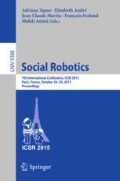Abstract
Social Signal Processing such as laughter or emotion detection is a very important issue, particularly in the field of human-robot interaction (HRI). At the moment, very few studies exist on elderly-people’s voices and social markers in real-life HRI situations. This paper presents a cross-corpus study with two realistic corpora featuring elderly people (ROMEO2 and ARMEN) and two corpora collected in laboratory conditions with young adults (JEMO and OFFICE). The goal of this experiment is to assess how good data from one given corpus can be used as a training set for another corpus, with a specific focus on elderly people voices. First, clear differences between elderly people real-life data and young adults laboratory data are shown on acoustic feature distributions (such as \(F_0\) standard deviation or local jitter). Second, cross-corpus emotion recognition experiments show that elderly people real-life corpora are much more complex than laboratory corpora. Surprisingly, modeling emotions with an elderly people corpus do not generalize to another elderly people corpus collected in the same acoustic conditions but with different speakers. Our last result is that laboratory laughter is quite homogeneous across corpora but this is not the case for elderly people real-life laughter.
Preview
Unable to display preview. Download preview PDF.
References
Vinciarelli, A., Pantic, M., Bourlard, H., Pentland, A.: Social signals, their function, and automatic analysis: a survey. In: Conference on Multimodal Interfaces (ACM), Chania, Greece, pp. 61–68 (2008)
Delaborde, A., Devillers, L.: Use of nonverbal speech cues in social interaction between human and robot: emotional and interactional markers. In: International Workshop on Affective Interaction in Natural Environements (AFFINE), Firenze, Italy (2010)
Breazeal, C.: Emotion and sociable humanoid robots. Human Computer Studies 59, 119–155 (2003)
Scherer, S., Glodek, M., Schwenker, F., Campbell, N., Palm, G.: Spotting laughter in natural multiparty conversations: A comparison of automatic online and offline approaches using audiovisual data. ACM Transactions on Interactive Intelligent Systems (TiiS) 2(1), Article No. 4 (2012). Special Issue on Affective Interaction in Natural Environments
Schuller, B., Batliner, A., Steidl, S., Seppi, D.: Recognising realistic emotions and affect in speech: state of the art and lessons learnt from the first challenge. Speech Communication 53(9), 1062–1087 (2011). Special Issue on Sensing Emotion and Affect - Facing Realism in Speech Processing
Batliner, A., Steidl, S., Nöth, E.: Laryngealizations and emotions: how many babushkas? In: Proc. Internat. Workshop on Paralinguistic Speech - Between Models and Data (ParaLing’ 07), Saarbrucken, Germany, pp. 17–22 (2007)
Batliner, A., Hacker, C., Steidl, S., Nöth, E., D’Arcy, S., Russell, M., Wong, M.: You stupid tin box - children interacting with the aibo robot: a cross-linguistic emotional speech corpus. In: LREC, Lisbon, Portugal, pp. 171–174 (2004)
Delaborde, A., Tahon, M., Barras, C., Devillers, L.: Affective links in a child-robot interaction. In: LREC, Valletta, Malta (2010)
McKeown, G., Valstar, M., Cowie, R., Pantic, M., Schröder, M.: The semaine database: annotated multimodal records of emotionally coloured conversations between a person and a limited agent. IEEE Transactions on Affective Computing 3(1), 5–17 (2012)
Tahon, M., Delaborde, A., Devillers, L.: Real-life emotion detection from speech in human-robot interaction: experiments across diverse corpora with child and adult voices. In: Interspeech, Firenze, Italia (2011)
Chastagnol, C., Clavel, C., Courgeon, M., Devillers, L.: Designing an emotion detection system for a socially-intelligent human-robot interaction. In: Towards a Natural Interaction with Robots, Knowbots and Smartphones: Putting Spoken Dialog Systems into Practice. Springer (2013)
Sehili, M.A., Yang, F., Leynaert, V., Devillers, L.: A corpus of social interaction between nao and elderly people. In: International Workshop on Emotion, Social Signals, Sentiment & Linked Open Data, Satellite of LREC (2014)
Tahon, M., Delaborde, A., Barras, C., Devillers, L.: A corpus for identification of speakers and their emotions. In: LREC, Valletta, Malta (2010)
Schuller, B., Zhang, Z., Weninger, F., Rigoll, G.: Selecting training data for cross-corpus speech emotion recognition: prototypicality vs. generalization. In: AVIOS Speech Processing, Tel-Aviv, Israel (2011)
Tahon, M., Devillers, L.: Laughter detection for on-line human-robot interaction. In: Interdisciplinary Workshop on Laughter and Non-verbal Vocalisations in Speech, Enschede, Netherlands (2015)
Brendel, M., Zaccarelli, R., Devillers, L.: Building a system for emotions detection from speech to control an affective avatar. In: LREC, Valletta, Malta (2010)
Ververidis, D., Kotropoulos, C.: Emotional speech recognition: Ressources, features and methods. Speech Communication 48(9), 1162–1181 (2006)
Schuller, B., Batliner, A.: Computational Paralinguistics: Emotion, Affect and Personality in Speech and Language Processing. John Wiley & Sons (2013)
Bachorowski, J.-A., Smoski, M.J., Owren, M.J.: The acoustic features of human laughter. Journal of the Acoustical Society of America 110(3), 1581–1597 (2001)
Campbell, N.: Perception of affect in speech - towards an automatic processing of paralinguistic information in spoken conversation. In: International Conference on Spoken Language Processing, Jeju Island, Korea (2004)
Szameitat, D.P., Darwin, C.J., Szameitat, A.J., Wildgruber, D., Alter, K.: Formant characteristics of human laughter. Journal of Voice 25(1), 32–38 (2011)
Devillers, L., Tahon, M., Sehili, M., Delaborde, A.: Inference of human beings’ emotional states from speech in human-robot interactions. International Journal of Social Robotics, Special Issue on Developmental Social Robotics (in press, 2015)
Schröder, M.: Experimental study of affect bursts. Speech Communication 40(1–2), 99–116 (2003). Special Session on Speech and Emotion
Author information
Authors and Affiliations
Corresponding author
Editor information
Editors and Affiliations
Rights and permissions
Copyright information
© 2015 Springer International Publishing Switzerland
About this paper
Cite this paper
Tahon, M., Sehili, M.A., Devillers, L. (2015). Cross-Corpus Experiments on Laughter and Emotion Detection in HRI with Elderly People. In: Tapus, A., André, E., Martin, JC., Ferland, F., Ammi, M. (eds) Social Robotics. ICSR 2015. Lecture Notes in Computer Science(), vol 9388. Springer, Cham. https://doi.org/10.1007/978-3-319-25554-5_63
Download citation
DOI: https://doi.org/10.1007/978-3-319-25554-5_63
Published:
Publisher Name: Springer, Cham
Print ISBN: 978-3-319-25553-8
Online ISBN: 978-3-319-25554-5
eBook Packages: Computer ScienceComputer Science (R0)

